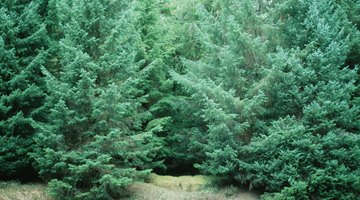Fraser Fir vs. Balsam Fir
The Fraser fir and balsam fir are closely related and share many characteristics. The two trees may have evolved from the same species. Both trees make excellent Christmas trees for their needle retention, deep green color, ideal shape and pleasing scent.

Location

Balsam firs are found in Canada and the northern United States. Fraser firs grow in the southern Appalachian Mountains and in parts of Virginia, North Carolina and Tennessee. The Fraser fir is sometimes known as the southern balsam fir.
Pinecones

The main difference between the Fraser fir and the balsam fir is the construction of their pinecones. The bracts, specialized leaves associated with the tree’s reproduction, are longer than the scales on a Fraser fir pinecone, which makes them curve downward. On a balsam pinecone, the bracts are shorter and hidden beneath the scales.
Size

Fraser firs typically reach heights of 80 feet, while balsam firs are shorter, at 40 to 60 feet. In Christmas tree farms, the Fraser fir matures slightly faster than the balsam. Fraser firs reach six to seven feet in seven to ten years, while balsams reach the same height in nine to ten years.
The Drip Cap
- The Fraser fir and balsam fir are closely related and share many characteristics.
- The bracts, specialized leaves associated with the tree’s reproduction, are longer than the scales on a Fraser fir pinecone, which makes them curve downward.
References
Writer Bio
I have been a professional historian, museum curator, and author for more than a decade. I have served as the Museums Editor at BellaOnline since 2004. I am qualified to serve as an expert in a variety of historical topics. My expertise includes the Victorian Age and McKinley's presidency, the Roaring Twenties, the 1950s, the flu, museum studies, material culture, architecture, and more. I have a BA in history and an MA in history museum studies from the Cooperstown Graduate Program. Please see my bio on my employer's website for more: http://www.mckinleymuseum.org/speakers_bureau/speaker/2
Photo Credits
- Photos.com/Photos.com/Getty Images
- Photos.com/Photos.com/Getty Images
- Oxyggen/iStock/Getty Images
- Zedcor Wholly Owned/PhotoObjects.net/Getty Images
- Mark Wagoner/iStock/Getty Images
More Articles



